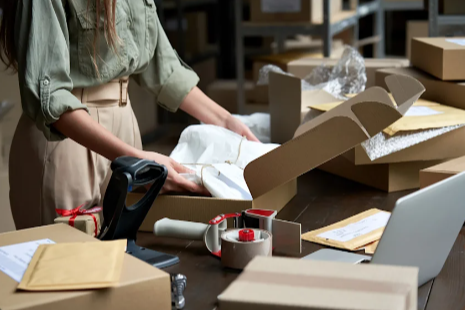
Exploring the Manufacturing Process of Corrugated Retail Display Boxes
Corrugated retail display boxes are essential components of modern in-store marketing, offering both aesthetic appeal and functional support for various products. The journey from raw materials to a finished display box involves a detailed and systematic manufacturing process. Understanding this process provides insight into the versatility, durability, and cost-effectiveness of these marketing tools. This article explores the key stages in the manufacturing process of corrugated retail display boxes, highlighting the precision and innovation involved.
Raw Material Selection
The manufacturing process begins with the selection of raw materials. The primary material used in corrugated retail display boxes is corrugated cardboard, which is made from a combination of paperboard layers. The inner layer, known as the fluting, is sandwiched between two outer layers of linerboard. The fluting provides structural strength, while the linerboards offer a smooth surface for printing and finishing.
The quality of the paper used in these layers is crucial. Typically, kraft paper, known for its durability and strength, is used for the outer linerboards. The inner fluting is often made from recycled paper, making the product both strong and environmentally friendly.
Corrugating the Cardboard
Once the raw materials are selected, the next step is the corrugation process. This involves creating the wavy or fluted layer of the cardboard. The process starts with heating the paper to make it pliable. The heated paper is then passed through corrugating rolls, which create the flutes. These flutes come in various sizes, depending on the strength and thickness required for the display boxes.
After the fluting is formed, it is glued between two linerboards using a strong adhesive. The combined layers are then passed through a series of rollers to bond them securely, creating a single sheet of corrugated cardboard. This sheet can then be cut into large rolls or sheets, depending on the production requirements.
Cutting and Shaping
The corrugated sheets are then cut and shaped according to the specifications of the retail display box. This stage involves precision cutting machines that ensure each piece is accurately sized. Die-cutting is a common method used in this phase. A die is a specialized tool that cuts the cardboard into specific shapes and sizes, incorporating slots, tabs, and other features necessary for assembly.
Die-cutting machines use high-pressure rollers to press the die against the cardboard, cutting through the layers cleanly. The result is a flat, pre-cut piece that can be easily folded and assembled into the final display box shape.
Printing and Design
One of the most critical aspects of corrugated retail display box is their visual appeal. This is achieved through high-quality printing and design. The pre-cut cardboard sheets are fed into printing machines that use techniques such as flexographic printing, lithographic printing, or digital printing to apply vibrant colors, logos, images, and text.
Flexographic printing is particularly popular due to its efficiency and cost-effectiveness. It involves creating flexible printing plates that transfer ink onto the cardboard. For more detailed and high-resolution graphics, lithographic printing or digital printing may be used. These methods provide superior image quality, making the displays more attractive to consumers.
Coating and Finishing
After printing, the corrugated sheets may undergo additional coating and finishing processes to enhance their durability and appearance. Common coatings include varnishes, laminates, and UV coatings. These coatings protect the printed surface from wear and tear, moisture, and UV damage, ensuring that the display boxes maintain their vibrant appearance throughout their use.
Finishing processes can also include embossing, debossing, and foil stamping to add texture and visual interest to the displays. These techniques elevate the aesthetic appeal of the boxes, making them more likely to capture consumer attention in a retail setting.
Read more Mastering Sales: 8 Proven Paths To Sales Success
Folding and Gluing
With the design and finishing complete, the next step is assembling the display boxes. This involves folding the pre-cut and printed sheets into their final shapes. Automated folding machines crease the cardboard along predefined lines, ensuring precise folds. Tabs and slots created during the die-cutting phase help hold the structure together. You can also have a look at Canadian packaging suppliers.
In some cases, additional gluing may be required to secure certain parts of the display. High-strength adhesives are applied to specific areas to ensure that the box remains sturdy and stable during its use. The glued sections are then pressed together and allowed to set, forming a robust and durable display box.
Quality Control
Quality control is a critical stage in the manufacturing process of corrugated retail display boxes. Each box must meet stringent standards to ensure it can withstand the rigors of the retail environment. Quality control checks include inspecting the strength and integrity of the cardboard, verifying the accuracy of cuts and folds, and ensuring the quality of the printed graphics.
Automated inspection systems and manual checks are used to identify any defects or inconsistencies. Boxes that fail to meet the required standards are either reworked or discarded. This rigorous quality control process ensures that only the highest quality display boxes reach the retail market.
Packaging and Distribution
Once the display boxes pass quality control, they are packaged for distribution. The flat-packed boxes are stacked and bundled to maximize shipping efficiency. Care is taken to protect the printed surfaces during transit, often using protective wrapping or interleaving sheets between stacked boxes.
The final stage involves distributing the corrugated retail display boxes to retailers. Efficient logistics and distribution networks ensure that the boxes arrive at their destinations in pristine condition, ready to be assembled and used in-store.
Conclusion
The manufacturing process of corrugated retail display boxes is a complex and detailed operation that combines material science, engineering, and design. From selecting high-quality raw materials to precision cutting, advanced printing, and rigorous quality control, each step is crucial to producing durable and visually appealing display boxes. These boxes play a vital role in in-store marketing, helping brands enhance product visibility, influence consumer behavior, and drive sales. Understanding the intricacies of their manufacturing process highlights the innovation and precision that go into creating these essential retail tools.






